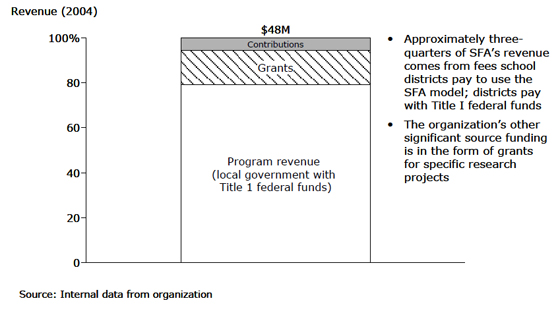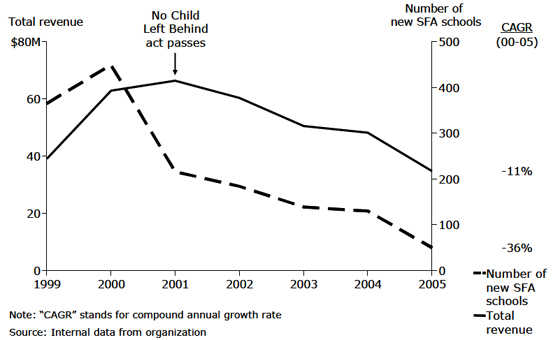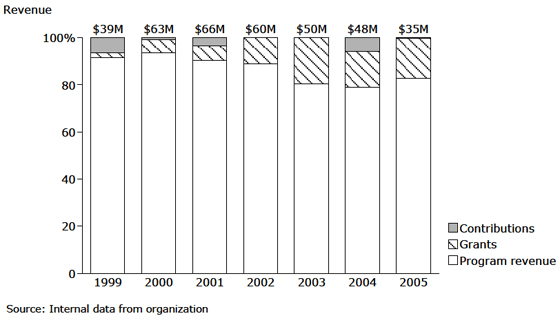There’s no way to avoid vulnerability to regulatory changes [like No Child Left Behind]. If you are going to work in poor areas, you have to access government money.
– Robert Slavin, Chairman
Overview
Related Content
How Nonprofits Get Really BigOrganization Profiles from How Nonprofits Get Really Big
Success For All (SFA) develops, evaluates, and disseminates proven reform models for preschool, elementary, and middle schools, with a particular focus on those serving at-risk children. Growing out of research by founders Bob Slavin and Nancy Madden of Johns Hopkins University, SFA combines a comprehensive school reform model with the belief that every child, including those at-risk and/or in poverty, can learn.
SFA’s program model relies on proven techniques, such as cooperative learning, phonics, frequent evaluation, and tutoring for remediation. For approximately $150 per child in the first year, and $50 to $75 in subsequent years, SFA provides training and materials to individual schools where at least 50% of students receive free or reduced-price lunch. Districts pay for SFA’s program with Title I federal funds.
SFA’s program is built specifically around the requirements of Title I funding, the largest single federal source of education funding. Title I money is intended to supplement standard activities in high-poverty schools with additional instructional staff, professional development, extended-time programs, and other strategies. Schools with at least 50% of students in poverty have more flexibility in the use of the funds.
After reaching its peak size of $66 million in 2001, SFA’s budget has declined to a 2005 level of $35 million. With the advent of No Child Left Behind and its Reading First component in 2001, schools began to shift away from SFA and similar programs to take advantage of federal money for traditional textbooks. Growth went from 350 to 450 new schools annually to 50 new schools in the 2005 fiscal year. SFA reduced its staff from 500 to 200, divested selected programs, and pared down to a core set of reading products.
Founding date: 1987
Revenue (2004): $48 million ($50 million in 2003)
Structure: Single organization
NCCS classification: Education
Services: Develops, evaluates, and disseminates proven reform models for preschool, elementary, and middle schools, with a particular focus on those serving at-risk children
Beneficiaries:Disadvantaged and/or at-risk students pre-kindergarten through 8th grade
Leadership (selected): Nancy Madden, President; Robert Slavin, Chairman
Address: 200 W. Towsontown Boulevard, Baltimore, Maryland 21204-5200
Website: www.successforall.org

Growth Story
- 1986 – The superintendent of Baltimore city schools asks Slavin and Madden for help improving the achievement levels of elementary school kids living in poverty.
- 1987 – Slavin and Madden begin SFA within Johns Hopkins University, with start-up funding from Carnegie Corporation, Abell Foundation, and federal research grants. The organization relies on Johns Hopkins for several administrative functions.
- 1991 – SFA receives a large grant from the New American Schools Development Corporation, allowing the organization to professionalize its program; expand into math, science, and social studies; and grow rapidly.
- 1997 – SFA becomes a stand-alone organization in response to its rapid growth. It maintains a strong connection to Johns Hopkins; for example, Johns Hopkins still pays the majority of Slavin’s salary.
- 1997 – Marion and Herb Sandler join the board.
- 2001 – The No Child Left Behind act, along with its Reading First plank, undercuts interest in SFA, causing a steep drop in new schools adopting SFA’s model. Reading First makes funds available for K-3 reading curriculum, but the majority of schools opt for traditional textbooks subsidized by Reading First rather than SFA-style reform plans. SFA responds by radically reducing costs, staff, and service lines. A large contribution from board members Marion and Herb Sandler sustains the organization during this lean period.
- 2005 – After several years of losses, SFA is a self-sustaining organization focused on core reading programs. The organization employs 200 staff, down from its peak of 500. The result is a smaller, more focused organization that can continue to impact education moving forward.
Revenue Trends
Revenue growth: As the number of new schools adopting the SFA program decreased, revenue followed.

Funding mix: Apart from episodic research grants and contributions, SFA relies on selling the SFA program materials and training services to school districts.

Actions That Helped Fund Growth
- Concentrated on a single funding source. SFA was built around a single source of revenue—the federal Title I statute that provides supplementary funding to schools in high-poverty areas. Despite episodic project-specific grants and contributions, all core programs have depended on this one source of revenue.
- Secured supplementary grants and contributions for product research, development, and evaluation. SFA refrained from using grant and foundation dollars to subsidize operations, plowing these moneys instead into product research, development, and evaluation—activities which were difficult to fund with its district contracts.
Funding Challenges
- Responding to legislative changes. In 2001, with the advent of No Child Left Behind and its Reading First component, schools began to shift away from SFA and similar programs to take advantage of federal money for traditional textbooks. Growth went from 350-450 new schools annually to 50 new schools in the 2005 fiscal year.
- Overcoming programmatic limitations associated with key funding source. SFA’s model was designed expressly to take advantage of districts’ Title I funding. It has found, however, that a gap exists between what districts can pay for and what’s required to transform classrooms. Given more flexible funding, SFA would engage in additional curriculum design and evaluation.
- Managing seasonal revenue streams. Working with schools gives SFA a highly seasonal revenue stream. Accordingly, cash reserves in combination with a line of credit are crucial. Typical capital requirements for the summer months are $3.5 million.

